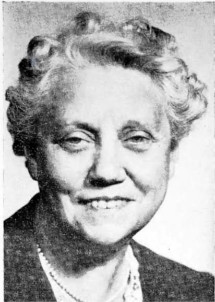Gertrude Lilian Entwisle facts for kids
Quick facts for kids
Gertrude Lilian Entwisle
|
|
|---|---|

fair use - no known owner
|
|
| Born | 12 June 1892 Swinton, Greater Manchester, England
|
| Died | 18 November 1961 Sale, Greater Manchester, England
|
| Nationality | British |
| Education | University of Manchester |
| Occupation | Electrical engineer |
| Known for | Engineering design |
Gertrude Lilian Entwisle (born June 12, 1892 – died November 18, 1961) was a pioneering electrical engineer. She achieved many 'firsts' for women in engineering in Britain. She was the first woman to work as an engineer at British Westinghouse. She was also the first female student, graduate, and associate member of the Institution of Electrical Engineers (now called the Institution of Engineering and Technology). Gertrude was famous for designing DC motors and other electrical machines. People said she broke down "barriers of prejudice" to become a respected engineer.
Contents
Early Life and Education
Gertrude Entwisle was born in Swinton, Lancashire, England, on June 12, 1892. Her parents were Elizabeth Ann and Thomas Henry Entwisle. She was the younger of two daughters. Her father worked as a clerk in a shipping warehouse.
Gertrude went to Milham Ford School in Oxford and Manchester High School for Girls. She earned a scholarship to the University of Manchester. She studied there from 1911 to 1914. At first, she studied physics with the famous scientist Ernest Rutherford. In her second year, engineering classes became open to female students. Gertrude then started attending them.
In July 1914, Gertrude did not pass her final physics exam. She left the university without getting her degree. Records show she might have planned to get married that year. However, there are no records of her ever marrying.
Starting Her Engineering Career
In 1915, during World War I, many skilled workers were needed. British Westinghouse (later called Metropolitan-Vickers) began hiring women engineers. The Chief Engineer, John S Peck, looked for suitable candidates. Gertrude heard about this opportunity and joined the company.
She first worked on checking test results for electrical equipment. Soon after, she moved into designing DC motors. At first, some managers were surprised when she wanted to enter the factory. They eventually agreed, as long as she did not wear trousers.
During the war, Gertrude also volunteered her time. She spent her weekends nursing at a Red Cross hospital. She also took evening classes at the Manchester College of Science and Technology.
A Long Career in Engineering
Gertrude continued working at British Westinghouse (which became Metropolitan-Vickers) after the war. The company did not hire married women at the time. She spent most of her career designing and helping to make AC and DC machines. She was especially good at designing DC motors.
In 1937, Gertrude took part in a debate at Metropolitan-Vickers. The debate topic was "That the Introduction of Female Apprentices to these works is to be deplored." Gertrude argued against this idea. She was joined by other women engineers like Dorothy Garfitt and Dorothy Smith. They won the debate, with 78 votes against the motion and 61 for it.
Towards the end of her career, Gertrude became an expert in designing 'exciters'. These are special machines that help power larger electrical generators.
Gertrude retired from Metropolitan-Vickers on June 20, 1954. She had worked there for 39 years as an electrical design engineer. She was the first British woman to complete a full career as a professional engineer in industry. In the 1950s, she gave a speech encouraging girls to become engineers. She said, "We are no longer at the stage when the appearance of a woman in the shops makes the whole place stop work, as it did when I started."
Joining Professional Groups
Gertrude wanted to be part of professional engineering groups. In 1916, she became a Student Member of the Institution of Electrical Engineers (IEE). She then became a Graduate Member in 1919 and an Associate Member in 1920. She was the first woman to reach each of these levels.
When she went to her first IEE lecture, the chairman stopped the meeting. He thought she might be a suffragette trying to cause trouble. It was hard for her to be accepted by other engineers. At her second IEE meeting, she was almost stopped from entering again. After arguing for half an hour, she was finally allowed in when the secretary confirmed she was a member.
Gertrude was also a founding member of the Women's Engineering Society (WES), started in 1919. She was on their Council and was the first secretary of the Manchester Branch. She later became Vice President and then President of WES from 1941 to 1943. She retired from the WES council in 1954, the same year she retired from her engineering job.
She was also involved with the Electrical Association for Women (EAW), which started in 1924. She was on their national committee and was the first secretary of the EAW's Manchester branch. Gertrude also belonged to other groups like the British Federation of University Women. She was also the first female member of the Society of Technical Engineers.

